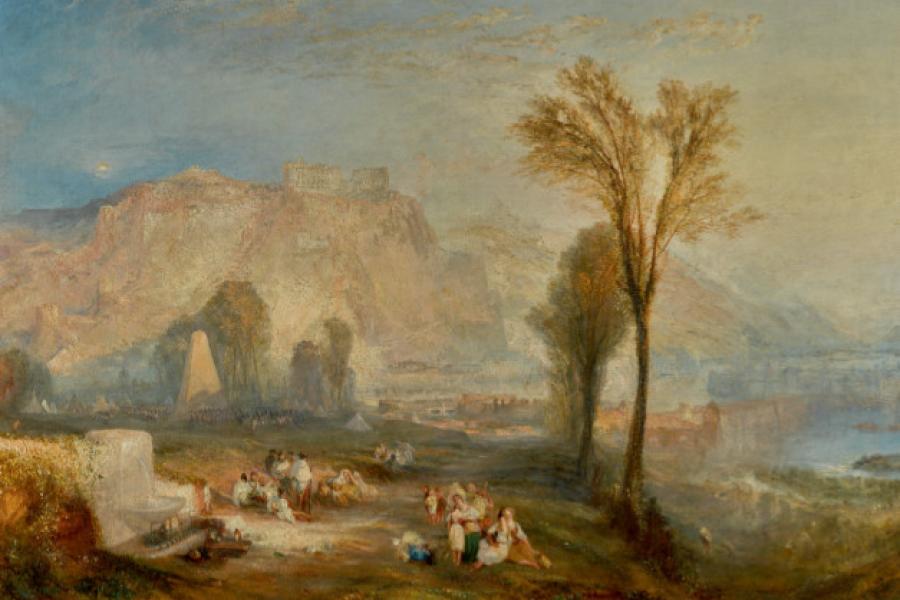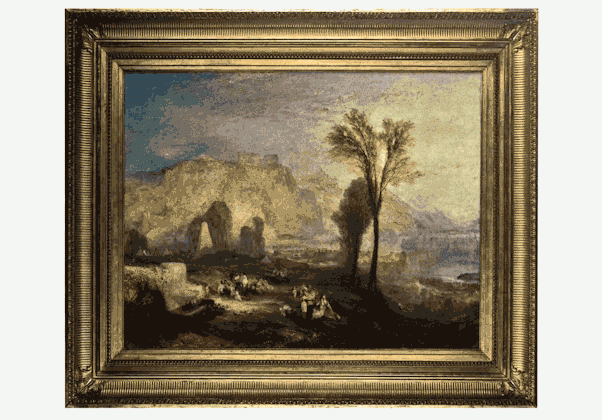One of the Greatest Works by Turner Still in Private Hands Comes to the Market
 Turner’s Ehrenbreitstein, estimate of £15-25 million (US$18.7-31.2m / €17.3-28.9m). - Mit freundlicher Genehmigung von: sothebys.com
Turner’s Ehrenbreitstein, estimate of £15-25 million (US$18.7-31.2m / €17.3-28.9m). - Mit freundlicher Genehmigung von: sothebys.comWas: Auktion
Wann: 05.07.2017
LONDON, 4 April 2017 – In July this year, Sotheby’s will offer for sale one of the greatest works by J.M.W. Turner still in private hands. Painted in 1835, Ehrenbreitstein is a late work, dating from a period that is widely considered Turner’s best: other works from this time now hang in the world’s greatest museums, with only a minute number of this importance and quality remaining in private ownership. The subject of enormous critical acclaim when it was first exhibited in 1835, the painting depicts the ruined fortress of Ehrenbreitstein near Coblenz – a place of special significance for Turner. Though he made many drawings and watercolours of German views, this is the most important oil painting of a German subject that Turner ever painted. The picture will be offered at Sotheby’s in London on 5th July with an estimate of £15-25 million (US$18.7-31.2m / €17.3-28.9m).
Often referred to as the ‘painter of light’, Turner is widely regarded as Britain’s foremost artist, whose unique and unprecedented style not only had a profound and lasting impact on British art, but was also a vital precursor to both the Impressionist and the much later Abstract Expressionist movements. (Monet openly acknowledged his indebtedness to Turner.) Major works of such astounding quality by Turner are rare on the international market. The last example to be offered (Rome, from Mount Aventine, painted in the same year as Ehrenbreitstein and offered at Sotheby’s in 2014) made a record £30.3 million/ $47.6 million – the highest price ever achieved for any British-born artist at auction, and placing Turner alongside Rubens and Raphael as one of just three artists from the pre-Impressionist era to have achieved prices at this level.
Julian Gascoigne, senior specialist in British Paintings, said: “Turner is one of those seminal figures who changed the way we see and think about the world. An artist rooted in the aesthetic philosophy and culture of his time, perpetually engaged with the art of both his predecessors and contemporaries, he was at the same time possibly the first ‘modern’ painter; who directly inspired the Impressionism of the nineteenth century, and presaged the Abstract Expressionism of the twentieth. These late works in particular, with their bold application of colour, treatment of light and deconstruction of form, revolutionised the way we perceive the painted image. By applying the techniques of a watercolourist to the use of oils, with successive layering of translucent colour thinly applied to the surface, which imbue his canvases with rich, hazy light, he gave his works an unprecedented poignancy and power that has rarely been rivalled since.”
Alex Bell, Co-Chairman of Sotheby’s International Old Masters Department, added: “This painting was one of five that Turner exhibited at the Royal Academy in 1835; the other four of which are now in some of the most distinguished institutions in the world. Of those five paintings, it was Ehrenbreitstein that caught the imagination of public and critics alike – and it’s easy to see why. Its extraordinary range and depth of colour, and typically inspired and imaginative use of light, would in any case mark this painting out as a masterpiece, but its true greatness lies in the way Turner applies his painterly genius to transform the ruins of the famous fortress into a poetic and symbolic image as resonant then as it is today.“
The area of the Rhine, and especially the fortress of Ehrenbreitstein, held particular resonance for Turner. He first visited the area in 1817 and would return many times over the years, producing countless drawings in his sketchbooks and numerous watercolours. This painting relates specifically to a series of sketches he produced during his third tour of Germany in 1833, when he travelled down the Rhine en route to Vienna and then Venice, via Salzburg.
GENESIS AND PROVENANCEThe painting was originally painted for the illustrious publisher John Pye, a close friend of Turner’s, as the basis for a large single plate engraving – one of the important select series of large prints by which the artist established his contemporary celebrity. Pye had anticipated the artist would produce a watercolour, along the lines of Turner’s previous Rhineland views. When it came to it, however, so engaged with the beauty and symbolic resonance of the subject was Turner that he felt he could only do justice to its scale and grandeur in oil, with all its depth of emotional power and complexity of diaphanous light. What he delivered to Pye was this magnificent 93cm x 123cm full Royal Academy exhibition oil painting.
Turner’s unanticipated rendering caused Pye a good deal of frustration – working up an engraving from a painting of this size and complexity was not the easiest of tasks, taking some eleven years to complete, with a number of terse exchanges along the way.
The arrangement, however, was always that the picture should be returned to Turner’s gallery on completion of the engraving, and it was here that it was seen and acquired by the man that would become one of Turner’s greatest patrons, Elhanan Bicknell. Bicknell may well have been introduced to Turner’s work by John Ruskin, a Herne Hill neighbour and a staunch advocate of Turner’s work. In the space of just two years, between 1841 and 1844, Bicknell acquired no fewer than seven large-scale masterpieces by Turner – the majority of which now hang in some of the world’s greatest museums, including Tate Britain, The Yale Centre for British Art, The Frick Collection, and The Metropolitan Museum in New York (see below for full details). On his death in 1863, Bicknell’s vast collection, including this painting, was dispersed at auction, generating huge excitement and achieving sensational prices. Since then the work has appeared only twice on the market, most recently in 1965, when it achieved a price of £88,000, setting a new world record for a work by the artist.
CRITICAL ACCLAIMThe mid-1830s saw the production of some of Turner’s most celebrated paintings. The great Rosebery view of Rome, from Mount Aventine, which sold at Sotheby’s in 2014 for a record £30 million ($47.6 million), would have been nearing completion in the artist’s studio when he set to work on Ehrenbreitstein, and The Fighting Temeraire was shown at the Academy just four years later.
In May 1835, Ehrenbreitstein was exhibited at the Academy alongside four other great works: Keelmen Heaving in Coals by Moonlight (now in the National Gallery of Art in Washington); Venice, from the Porch of Madonna della Salute (The Metropolitan Museum of Art, New York); Line Fishing off Hastings (Victoria and Albert Museum, London); and The Burning of the Houses of Lords and Commons (The Cleveland Museum of Art, Ohio). Of all five exhibits, however, it was Ehrenbreitstein that the public loved most, and that the critics judged the best. The correspondent for The Spectator called it ‘a splendid tribute of genius to one of the champions of freedom’, whilst The Times lauded ‘the force of colour and the admirable harmony of tone [which] are not to be equalled by any living artist’.
THE SUBJECT OF THE PAINTINGMore than just a landscape, Turner’s full title for the painting, Ehrenbreitstein, or The Bright Stone of Honour and the Tomb of Marceau, from Byron’s Childe Harold, reflects a passage from Canto III of Lord Byron’s epic poem, Childe Harold’s Pilgrimage – bringing together two of the most romantic figures of the nineteenth century. Turner shared Byron’s romantic sensibilities and had long held him in the greatest admiration. Also, both had lived through the tumult of the French Revolutionary wars, and both had a keen sense of the deep significance of the ensuing peace.
In the poem Byron refers to the fortress of Ehrenbreitstein in the context of his own sense of melancholy and disillusionment in the aftermath of those wars. But for Turner it would seem that the fortress represents something more positive: that peace has vanquished war. The ancient fortress, almost dissolved in a hazy light, is now but a backdrop to the enduring everyday activities of the Rhine and Moselle valleys.
Beneath the fortress can be seen the stone obelisk to the great French General François-Sévérine Marceau-Desgraviers. Having taking part in the sieges of Ehrenbreitstein in 1795 and 1796, Marceau was a French hero par excellence. At the same time, his courage and magnanimous nature won him the respect of even his greatest enemies. His funeral, just north of Coblenz, was attended by a delegation from the same Austrian army who had been responsible for his death. Like the fortress itself, Marceau has slipped into history but still represents the possibility of peace and unity in Europe.
In Ehrenbreitstein, Turner has created an image that speaks in a profound way to both the eye and the mind – a duality that is at the heart of his unique artistic genius.
Tags: Malerei, William TurnerEHRENBREITSTEIN - TRAVELLING EXHIBITION:Cologne: Los Angeles: New York: Hong Kong: Paris:5th April1st - 3rd May (by appointment) 5th - 15th May25th - 31st May10th - 12th June
 William Turner animation click images. - Mit freundlicher Genehmigung von: sothebys.com / Sotheby’s Auktionshaus
William Turner animation click images. - Mit freundlicher Genehmigung von: sothebys.com / Sotheby’s AuktionshausCopyright © 2025 findART.cc - All rights reserved
